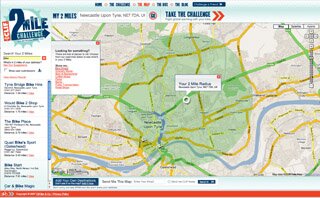Beauty is in the eye of the bicycling beholder
Or, how far are commuter cyclists willing to travel out of their way if the route is nicer?
This is a big issue for some cycle advocates. Many diehards fear that city planners want to shunt cyclists on to Sustrans-style cyclepaths (which are few and far between) to make room on the roads for more cars. Roads go almost everywhere and cyclists who want to use the fastest, most direct route want to retain their rights to ride alongside motorised traffic.
“The fast cycle commuter must not be driven off the highway onto a route that is designed for a 12-year-old or a novice on a leisure trip, because if that happens, the whole attempt to enlarge the use of the bicycle will have failed.”
Book review, The National Cycle Network-guidelines and practical details, M.N. Fargher, Proceedings of the Institute of Civil Engineers, Transport, 117, August 1996
Of course, when a cyclepath cuts a swathe through the city and offers a more direct, prettier route – via a scenic riverside route, for instance – it makes perfect sense to use that route rather than the road route. As superior beings, using the most efficient transport mode on the planet, we want our bread buttered on both sides.

Following on from yesterday’s discussion of isocrones I’d like to share some US transport planning research from the 1970s. Boris S Pushkarev with Jeffrey M Zupan measured the distances people travelled, their modes of getting from A to B and how each journey was enjoyed.
Zupan and Pushkarev found that the willingness to walk somewhere falls off drastically at about half a mile. However, they also found that people will travel longer distances and for longer times in order to pass through a more enjoyable environment. Naturally, pedestrians will not follow a path that seems to take them out of their way or makes them walk further. But people are willing walk longer distances, even circuitous routes, if they believe the route is better for their senses and/or more efficient in terms of time taken. Given this, an important factor for pedestrians – and, by extension, cyclists and motorists – is time to destination not distance. Perhaps even more important is the perception of time and the quality of the environment.
When people are told about great new cycle paths or walking routes, they use them. (PTP) - as used successfully in the Cycling Demonstration Towns - can cut car use by 10 per cent, says the Department for Transport:
PTP encourages people to consider alternative transport options to the car. Today’s research shows it can reduce the number of car journeys drivers make by 10%, and the overall distance travelled by car by 11%. It also offers value for money for local authorities, giving an average £30 return on every £1 invested over a 10-year period.
And PTP is now breaking through to the mainstream. The BBC has carried a story on the concept and proof that PTP must work can be deduced by the fact Daily Mail columnist Richard Littlejohn has lampooned it.
Have you considered one of those bicycles that the Goodies used to ride on television?
You can get three up and Halford’s will sell you a trailer to go on the back, made out of recycled toenails from Afghanistan, which comes with the Greenpeace seal of approval, yours for only £999.99 plus VAT.
Don’t worry if you can’t ride a bike, we can offer full training, in 23 different languages, including scribble.
FURTHER READING:
Urban Space for Pedestrians, MIT Press, 1975.
Public Transportation and Land Use Policy, Indiana University Press, 1977.
Both by Boris S Pushkarev with Jeffrey M Zupan
LONDON TRAVEL PLANNER:
Transport for London’s Journey Planner has a ‘cycle there’ tick box. It gives the average journey time but doesn’t yet allow the user to specify ‘most scenic route’.


